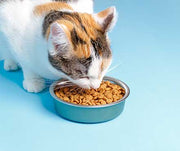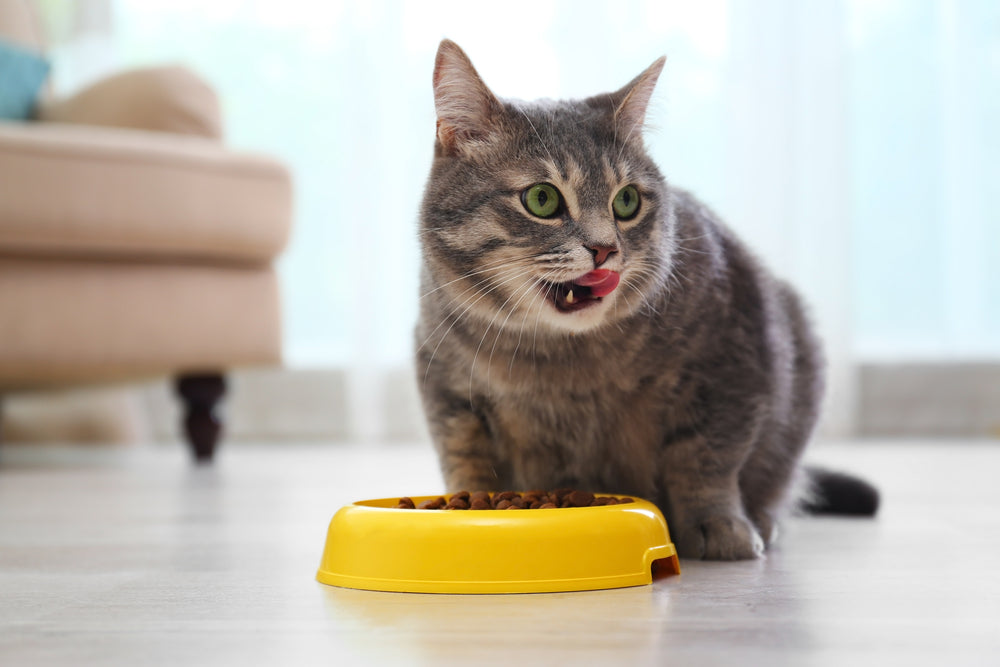Wet Vs. Dry Cat Food - Is One Better?

As a loving pet parent to your precious kitty, you want nothing but the best for them. So naturally, when it comes to feeding them, you want to opt for the cream of the crop. When purchasing cat food, you usually have two options: dry cat food in a bag or canned wet food.
Whether you've just brought home a new kitty or are looking to transition to a new food, the decision process can be overwhelming. Veterinarians and cat owners have long argued over whether wet food or dry food is better for cats. In this guide, we're going to go over some of the pros and cons of wet and dry cat food, things to consider, and how to make the best decision for your cat.
What is the Difference Between Wet & Dry Cat Food?
It's important to establish that both wet canned food and dry food from trusted brands are nutritionally complete. Below, we're going to cover some of the key differences between wet and dry cat food.
Moisture Content
As you likely guessed from the differences in their name, the biggest difference between wet and dry cat food is the moisture levels in each. Dry cat food, or kibble, contains only about 10% water, with the remaining 90% consisting of carbohydrates, fats, vitamins, and possibly fibers.
Nutrients
As for nutrient levels, dry food tends to have more carbohydrates than wet varieties, which tend to have more protein and fat. Exact formulations will vary by brand.
Wet Food
Pros:
1. Water Content: The higher water content in wet food makes it easier for your cat to stay hydrated. While ensuring proper hydration is beneficial to every cat, this can be especially helpful for cats with certain medical conditions, such as urinary and kidney issues. The higher water content in wet cat food helps to flush out urinary crystals as well as reduce future crystal formations.
2. Comes in Pre-Measured Portions: Feeding your cat the proper portions is just as important as feeding your cat. Some cats may need a little more discipline at mealtime and require their owners to measure out each meal. May wet food varieties come in pre-measured portions to help save time.
3. Easier for Cats to Chew: The softer texture of wet food can make it much easier for cats to chew, especially senior cats with missing teeth or other dental issues.
4. Cats Love the Flavor: Due to the method of preparation, wet food tends to be more palatable than dry food, which is a major benefit if your cat is a picky eater.
Cons:
1. Cost: Perhaps the biggest drawback to feeding your cat wet food is the cost. Compared to dry food, wet food costs more per ounce. The extra moisture content makes wet food less nutrient-dense, meaning you'll need to buy more cans to ensure your cat gets all the necessary nutrients.
2. It's More Easily Perishable: Once the can is open, wet food is quickly perishable. Any cat food leftover in the can will need to be immediately covered with a secure can topper and refrigerated. Additionally, you'll have to pick up your cat's food after a couple of hours at most, even if your cat hasn't finished, or it will spoil. Constantly having to throw out spoiled wet food can lead to tremendous waste.
Dry Food
Pros:
1. Price: The biggest pro of feeding your cat dry food is the price. Buying dry cat food by the bag is less expensive than buying wet food, making it a more budget-friendly option.
2. Doesn't Need to be Refrigerated: Kibble doesn't need to be stored in the fridge once you open the bag. This "shelf-stable" status allows for free feeding, meaning you can leave dry cat food out in a bowl at all times. This may be a better option for people with busier schedules, as well as cats who are slow eaters and prefer to nibble at their bowl throughout the day. Dry food also works with automatic pet feeders. You won't need to worry about dry food spoiling, but it will lose its taste and nutrition value if left out for several days. Regardless, practicing proper food storage is still important.
To keep your cat's dry food as fresh as possible, consider investing in a Vittles Vault Food Storage Container. Made with patented Gamma Seal Technology, these storage containers have seals that keep harmful moisture and light out of the container while creating an airtight food storage solution that keeps every last piece of kibble as fresh as possible.
Cons:
1. Much Lower Moisture Content: While the lower moisture content in dry cat food shouldn't come as a surprise, this can lead to dehydration if your cat is not getting enough water elsewhere.
2. Lower in Protein, Higher in Carbohydrates & Fillers: Cats are obligate carnivores, which means their diets require animal protein. Dry food is usually higher in carbohydrates and other fillers. While cats can digest and certainly gain nutrients from carbohydrate sources, their diets don't really require them.
The Verdict
In the end, your cat will decide which food they like better, as each kitty has their individual taste and preferences. If your cat is healthy overall, the most important thing is that your cat is fed with proper portion control in mind. There is always the option of blended or mixed feeding, in which you feed your cat both wet and dry food. This allows your cat to get the best of both worlds and can help to break up the monotony of eating the same thing every day.
As always, if you have any questions or concerns regarding your cat's diet, contact your veterinarian.
Previous article

Next article

Related posts
View all-

Wet Vs. Dry Cat Food: Which is Better?
As a caring cat owner, you always want the best for your furry friend, especially with their food. You typically have two choices: dry cat food in a bag or canned wet food. Whether you've just brought home a new kitty or are looking to transition to a new food, the decision process can be overwhelming, and understanding the impact of each on your cat's diet is essential. Read Article -

Celebrate National Pet Week: Fun Ideas to Celebrate with Your Pet
National Pet Week is right around the corner, so it's time to plan how you're going to celebrate! While we're sure you celebrate your pet all day every day... Read Article -

5 Simple Tips to Make Sure Your Cat Drinks Enough Water
Ensuring your cat stays hydrated is important, but it can be challenging since many cats don't drink enough water. Dehydration can lead to kidney disease and other health issues. Fortunately, you can encourage your cat to drink more with a few simple changes. Read Article



